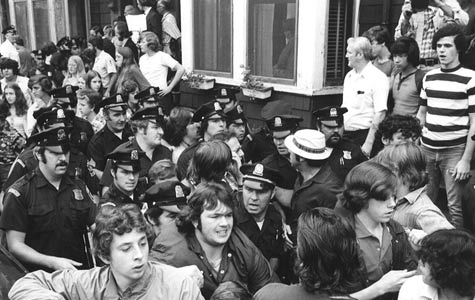
Photo: Ken Kobré
Police clear the street in front of South Boston Hospital, September 12. 1974.
|
This article originally appeared in the September 17, 1974 issue of the Boston Phoenix
Thursday, 7:45 a.m., outside South Boston High School. Down G Street from the top of the Hill, the harbor is almost invisible through the haze. It is already hot.
The school is large, old, yellow, set back from the street. On one of the side doors there is spraypaint that has not yet been covered over.
"Everyone Should Own a Nigger," says the spraypaint. "No Niggers in SB." "Kill Niggers."
Police Commissioner Robert DiGrazia stands near the front gate, conferring with officials, then moves toward a group of reporters.
"Make sure you leave a little passageway," he says, "for the kids who might have enough balls to show today."
DiGrazia is worried. He will tell reporters, later in the day, that he called reinforcements to Southie after getting a look at the crowd.
There are several hundred in that crowd now, most of them teenagers, most of them lined up in front of the threedeckers that face the school across G Street. They fill the sidewalks and spill out into the street, facing a line of cops. There is a street that runs into G directly in front of the school, and the cops keep it open, dividing the crowd into two clusters. The buses will come down that street.
There are older people in the crowd as well, some middle-aged men, some who look to be in their early twenties. But there are more older women: they stand together by and large, many of them on the stoops to the threedeckers.
For a while they are fairly quiet, trading nasty remarks about "the niggers," warming up.
A priest moves through the kids, one of several local clergymen on hand to try to cool things, and a short woman with red hair points at him angrily.
"Lookit him," she shrieks. "He's here to give last rites to a nigger."
The woman's friends on the stoop chuckle.
It's on account of Medeiros," says one. "They're standing up for 'em now."
At 7:50 the crowd lets out a roar. The first bus has arrived, pulling up quickly from the sidestreet to the front gate of the school, and five or six kids get out.
They are all white. The crowd howls out appropriate insults, ordering them not to enter.
They do anyway, accompanied by headmaster William Reid. Of the 124 kids who will enter the school's main building opening day -- where the enrollment is supposed to be 1300 -- almost 70 will be whites.
("Most of them weren't bused," said one mother later whose child did attend. "They kinda snuck in, wearing crummy clothes so they wouldn't stand out. And you see those cars," she said, pointing to the continuous stream of traffic that circled the school and the adjoining Thomas park, "I know some of them are mothers who're checking it out, seeing if it's okay to send their kids.")
A few minutes before eight, headmaster Reid appears again and moves toward the crowd, accompanied by a cop in plain clothes.
"What do you say, people?" he says. "Now go to school or go home."
No one says anything. Reid moves back across the street and is waiting there when -- almost on the stroke of eight -- the first bus with black kids aboard pulls up.